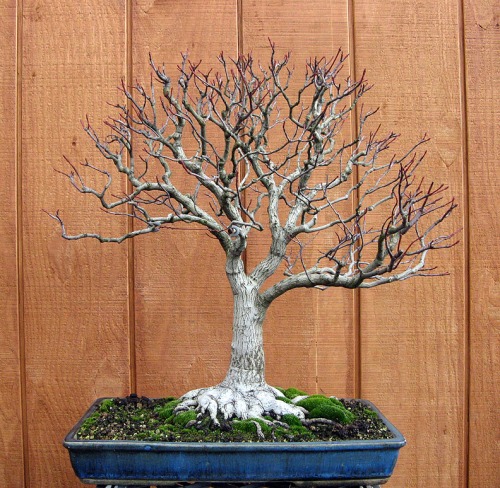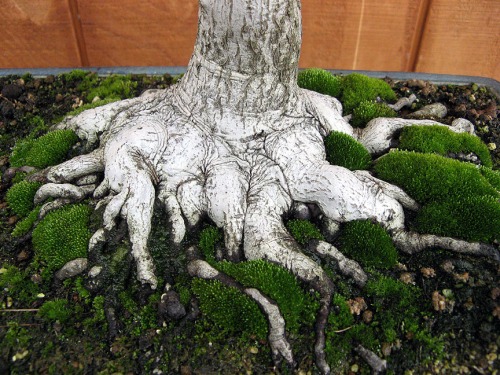This is the same tree as the previous post. I’d taken that picture in leaf, took a trip, and when I came back it was completely bare. Here’s a winter silhouette, and, since several commented on it, a close-up of the nebari.
Read more!
Monday, October 31, 2011
Sunday, October 30, 2011
Bonsai tree: Bonsai Bark’s Weekly Wire #5
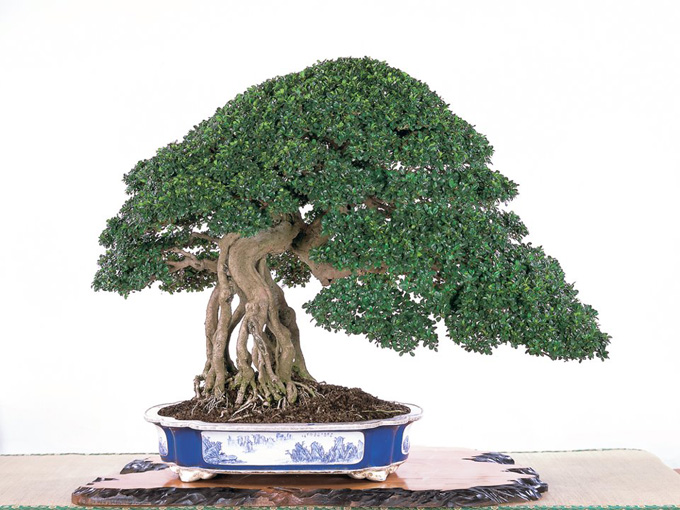 Loud and clear. This magnificent Fukien tea and it’s perfect pot speak for themselves, so I won’t say anything. Except that it’s from Taiwan Bonsai World (facebook), the botanical name is Carmona microphylla and the artist is HUANG, Qing-Quan.
Loud and clear. This magnificent Fukien tea and it’s perfect pot speak for themselves, so I won’t say anything. Except that it’s from Taiwan Bonsai World (facebook), the botanical name is Carmona microphylla and the artist is HUANG, Qing-Quan.Post your upcoming events here (in the comments below) and we’ll feature them in our next Weekly Wire. Most calendars on bonsai sites only run through this year, and don’t have much in the way of events this time of year anyway. It would be good if people would start putting up next year’s events (a few have begun, but the pickings are quite slim) so we’d have more to tell you about.
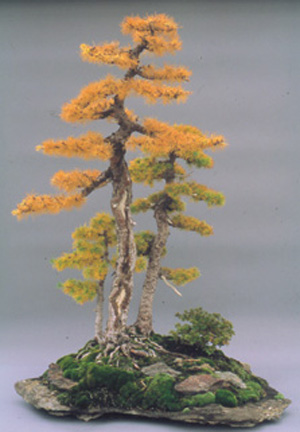 A sweet fall color larch planting from the North American Collection
A sweet fall color larch planting from the North American Collection(Les bonsaïs nord-américains) at the Montreal Botanical Garden.
The North American Collection is one of several world-class bonsai collections at these fabulous gardens.
 Tradition in bonsai. Our old friend and colleague Andy Rutledge (The Bonsai Journal) puts the following question to five prominent bonsai artists: What is the role of tradition in the art of bonsai? Andy also has an excellent, in-depth article titled Life at a Bonsai Nursery about time he spent working at New England Bonsai Gardens.
Tradition in bonsai. Our old friend and colleague Andy Rutledge (The Bonsai Journal) puts the following question to five prominent bonsai artists: What is the role of tradition in the art of bonsai? Andy also has an excellent, in-depth article titled Life at a Bonsai Nursery about time he spent working at New England Bonsai Gardens.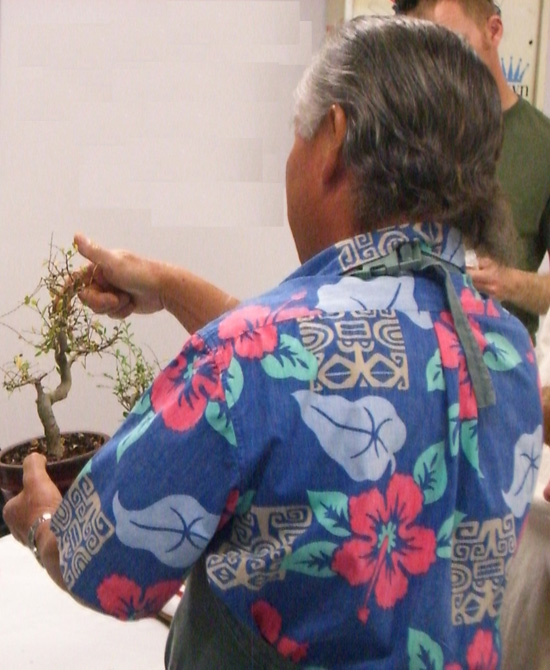 Roy Nagatoshi’s colorful floral pattern shirt at a Bonsai Society of Greater St Louis workshop. Roy is the proprietor of Fuji Bonsai and a much loved bonsai teacher to many.
Roy Nagatoshi’s colorful floral pattern shirt at a Bonsai Society of Greater St Louis workshop. Roy is the proprietor of Fuji Bonsai and a much loved bonsai teacher to many.
The Ottawa Bonsai Society website features galleries, articles and calendars of upcoming meetings and events.
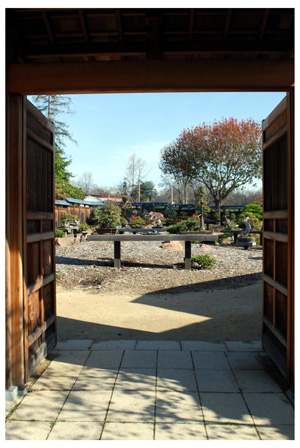
Bay Area Bonsai riches. You can enjoy a ‘bring your own bonsai’ workshop at the Bonsai Garden at Lake Merritt (Oakland CA) the 4th Sunday of each month. Kathy Shaner, one of the West’s most distinguished bonsai artists, is the curator, though it’s not clear if and when she ever leads the monthly workshops.
Stay posted for more on this excellent bonsai garden. Their site is exceptionally rich with events, photos and more, and worth continued exploration.
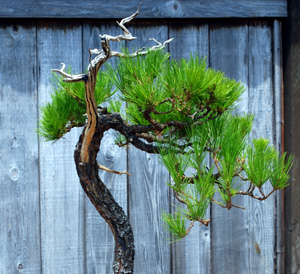
Bonsai Detective Art Contest Winner. Congratulations to Dave Piemme, the winner of our Bonsai Detective Art Contest. We’ll have more to say about Dave and the contest in our next Weekly Wire, so stay posted.
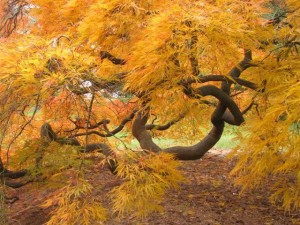 Fall Color: In the Foliage, In the Garden, and In the Collections.
Fall Color: In the Foliage, In the Garden, and In the Collections.At the US National Arboretum. November 5.
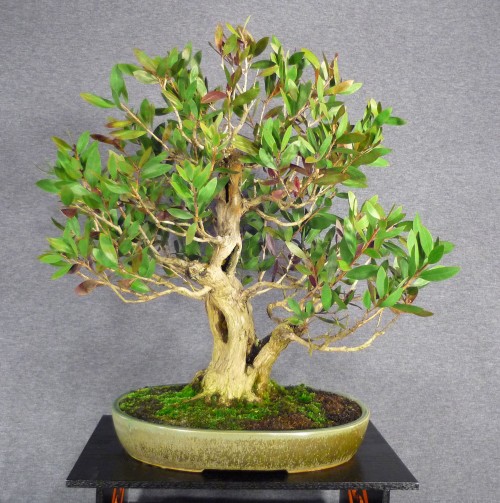 Another worthy Bottlebrush. In our last Weekly Wire we featured a Bottlebrush from the National Bonsai & Penjing Collection of Australia, which led me to comment that I didn’t think I’d ever seen an impressive Bottlebrush bonsai before. Now, thanks to Bruce Winter (Volcano Hawaii), I’ve now seen another even better Bottlebrush bonsai. Too bad it’s not flowering in this photo, but still…. BTW, there’s an article about Bruce in the Redwood Empire Bonsai Society newsletter.
Another worthy Bottlebrush. In our last Weekly Wire we featured a Bottlebrush from the National Bonsai & Penjing Collection of Australia, which led me to comment that I didn’t think I’d ever seen an impressive Bottlebrush bonsai before. Now, thanks to Bruce Winter (Volcano Hawaii), I’ve now seen another even better Bottlebrush bonsai. Too bad it’s not flowering in this photo, but still…. BTW, there’s an article about Bruce in the Redwood Empire Bonsai Society newsletter.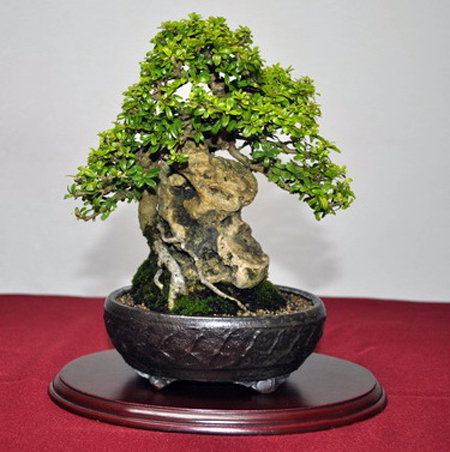 It’s a mystery. Neea buxifolia, root-over-rock. You don’t see too many of Neea bonsai.
It’s a mystery. Neea buxifolia, root-over-rock. You don’t see too many of Neea bonsai.I’d like to tell you who this one belongs to, but lost the link and artist’s name. Anyone?

It’s about time. Stone Lantern’s immensely popular Okatsune Sharpening Stone is finally back in stock. It’s popularity derives from he fact that one side is rounded so it’s perfect for sharpening round blades. And like all things Okatsune, the quality is unrivaled.
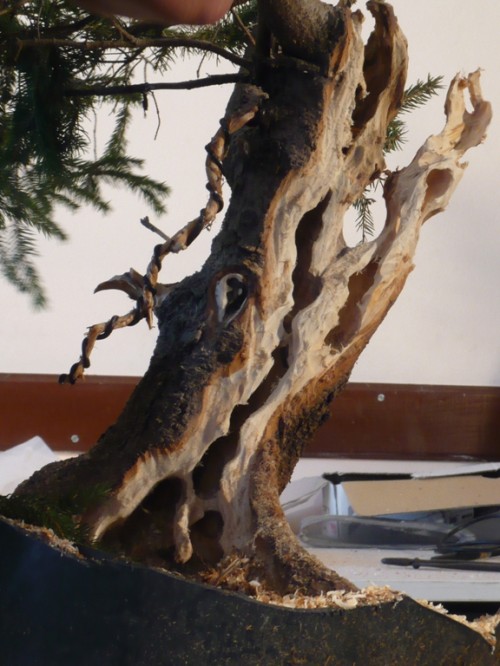 Kevin Wilson’s handiwork from a bonsai carving demo in Croatia last month (bonsai4me). I’ve been a fan of Kevin’s daring approach to carving every since we ran Styling and English Yew in Bonsai Today 106.
Kevin Wilson’s handiwork from a bonsai carving demo in Croatia last month (bonsai4me). I’ve been a fan of Kevin’s daring approach to carving every since we ran Styling and English Yew in Bonsai Today 106.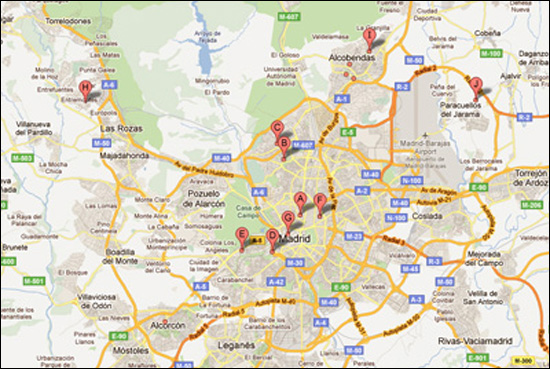 Spain’s bonsai hotspot. This google map shows ten bonsai destinations around Madrid. I haven’t been there, nor did I check to see if each one is legit, but still, Madrid looks like a pretty good place for bonsai lovers.
Spain’s bonsai hotspot. This google map shows ten bonsai destinations around Madrid. I haven’t been there, nor did I check to see if each one is legit, but still, Madrid looks like a pretty good place for bonsai lovers.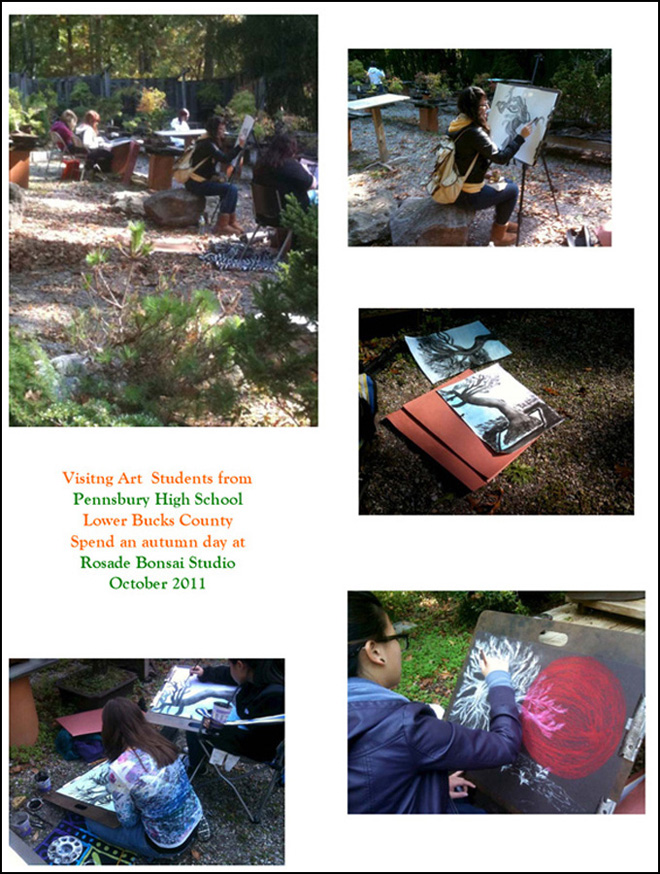 A peaceful autumn day. From the Rosade Bonsai Studio newsletter.
A peaceful autumn day. From the Rosade Bonsai Studio newsletter.Source: Bonsai Bark Read more!
Friday, October 28, 2011
Bonsai tree: Bunjin Bonsai Bliss
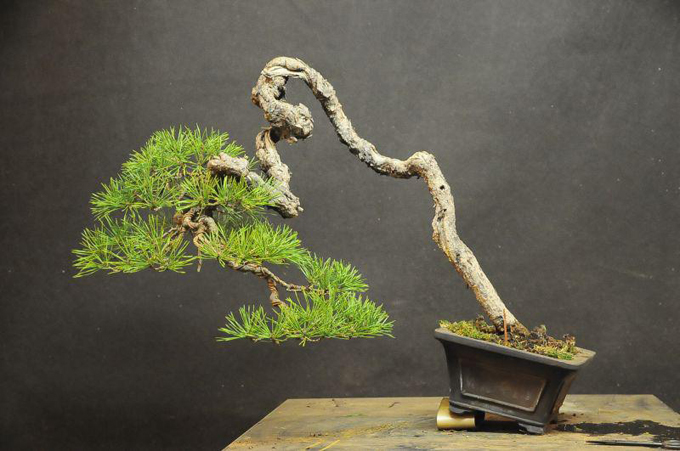 Unfinished, but oh so wild and wonderful. I wonder what this Scot’s pine bunjin beauty looked like before it was collected somewhere in the wilds of Sweden. It belongs to Muaro Stemberger. It’s from his facebook page. Mauro also has a website. It’s called Italian Bonsai Dream.
Unfinished, but oh so wild and wonderful. I wonder what this Scot’s pine bunjin beauty looked like before it was collected somewhere in the wilds of Sweden. It belongs to Muaro Stemberger. It’s from his facebook page. Mauro also has a website. It’s called Italian Bonsai Dream.Bunjin or Literati, bonsai elegance by any name
The following is from something I wrote for The Magician: The Bonsai Art of Kimura.
“Bunjin style bonsai originated in China among scholars and artist who were known as literati, which is another name for bunjin. Originally, literati style bonsai – which dates back to the Tang Dynasty (618-907) – was influenced by Chinese brush painting. With a little imagination, the connection can be readily seen.
Perhaps the keys to understanding bunjin are the notions of simplicity and elegance. These qualities arise as expressions of freedom; freedom from conventional and habitual way thinking, doing and seeing. This type of freedom – which is highly valued in some traditional societies and is not easily obtained – results in a direct and immediate way of experiencing the world. This could be called intuition…”
That’s enough for now (I know your time is precious). If you’re one of those strange people who likes to read the ramblings of others, you can always purchase (our peruse your copy of) The Magician.
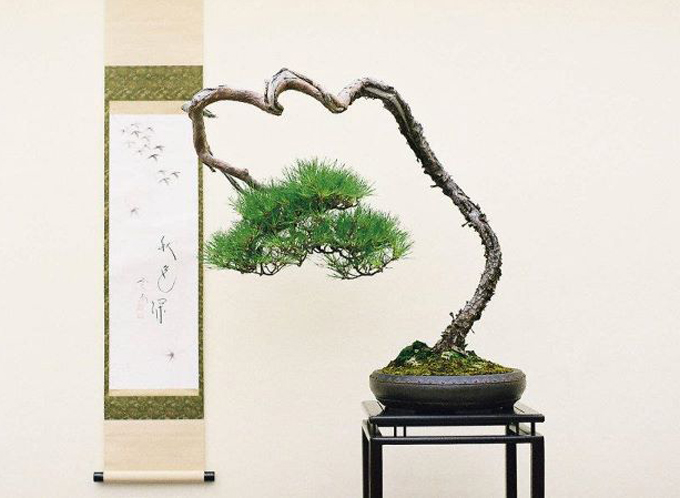 This triple humpbacked pine combines elegance and a rugged wildness. I don’t know who it belongs to (please don’t show me up by pointing out that it’s in an issue of Bonsai Today or one of our books, there’s no more room on my face for any more egg), but I’d guess that it’s Japanese. It’s from Lombok’s photos on facebook. Like about half of the bonsai you find on facebook, it’s unattributed.
This triple humpbacked pine combines elegance and a rugged wildness. I don’t know who it belongs to (please don’t show me up by pointing out that it’s in an issue of Bonsai Today or one of our books, there’s no more room on my face for any more egg), but I’d guess that it’s Japanese. It’s from Lombok’s photos on facebook. Like about half of the bonsai you find on facebook, it’s unattributed.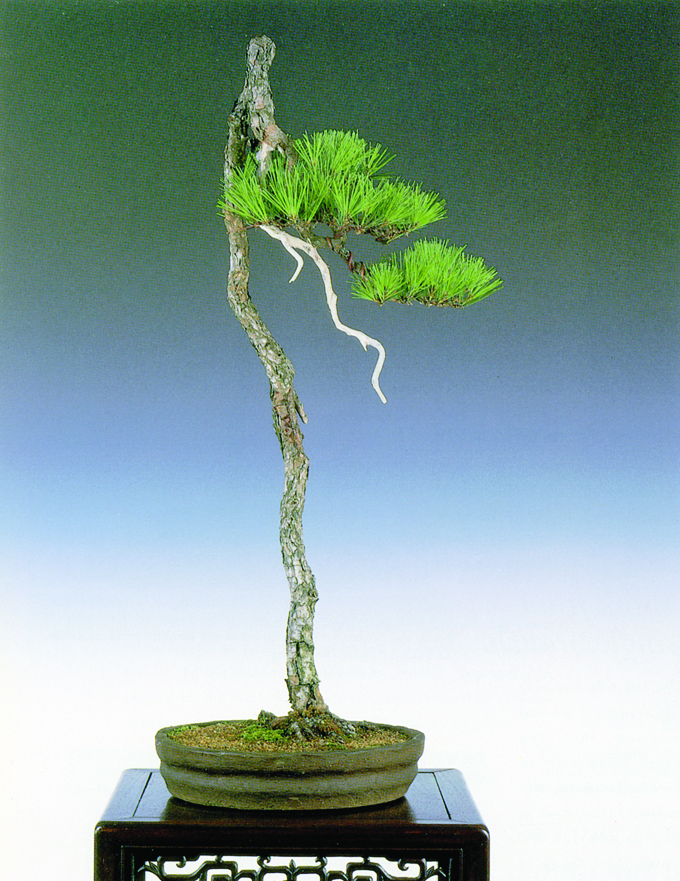 A study in simplicity. This Japanese Red pine (Pinus densiflora) is the result of a challenge to Masahiko Kimura (the world’s best know bonsai artist) to create a bonsai with only one branch. It’s from The Magician: The Bonsai Art of Kimura 2. The original article is from Bonsai Today issue 69.
A study in simplicity. This Japanese Red pine (Pinus densiflora) is the result of a challenge to Masahiko Kimura (the world’s best know bonsai artist) to create a bonsai with only one branch. It’s from The Magician: The Bonsai Art of Kimura 2. The original article is from Bonsai Today issue 69.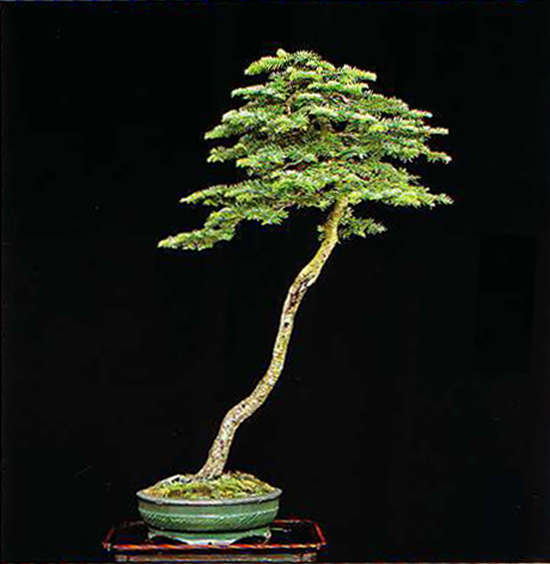 Few and far between. Have you ever seen a true fir (Abies) bonsai? How about a bunjin fir bonsai? This one is a Grand fir (Abies grandis) that belongs to Lee Cheatle. Grand firs are native to the Pacific Northwest. The photo is from the 2010 US National Bonsai Album.
Few and far between. Have you ever seen a true fir (Abies) bonsai? How about a bunjin fir bonsai? This one is a Grand fir (Abies grandis) that belongs to Lee Cheatle. Grand firs are native to the Pacific Northwest. The photo is from the 2010 US National Bonsai Album.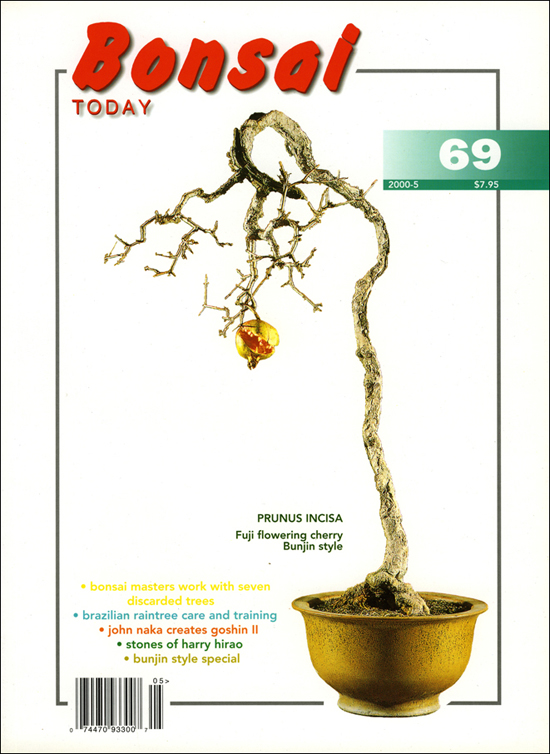 Bunjin is not just about pines. Bonsai Today back issues (including this bunjin special) are currently 70% off at Stone Lantern.
Bunjin is not just about pines. Bonsai Today back issues (including this bunjin special) are currently 70% off at Stone Lantern.Source: Bonsai Bark Read more!
Bonsai tree: East Bay Bonsai Society’s 50th Anniversary Bonsai Show
Source: Bonsai Tonight
East Bay Bonsai Society’s 50th Anniversary Bonsai Show
The East Bay Bonsai Society hosted their 50th Anniversary Bonsai Show at the Lakeside Garden Center in Oakland, California, on October 8th and 9th. The show featured a workshop, demonstration and critique by Kathy Shaner, sales and vendor areas, and plenty of bonsai and suiseki. The show program included a history of “The First 50 Years of the East Bay Bonsai Society.” I’ve reproduced it here as it recognizes the considerable effort its members have made over the years to the organization and to the larger bonsai community.
“The East Bay Bonsai Society (EBBS) traces its origins to 1961 when Jack Dutro, seeking people interested in bonsai, placed a guest book at the bonsai display of the California Spring Garden and Home Show. Over a hundred and twenty-five people signed the book and ultimately met with Jack, Harvey and Grace Suzuki, Nelson and Lillian Dennis at the Lakeside Garden Center in Oakland on Wednesday, October 11, 1961. Jack Dutro’s interest in bonsai began in 1939 when he visited the Japanese Pavilion at the San Francisco and Golden Gate International Exhibition at Treasure Island. Jack served as the first president of EBBS, sharing his knowledge, expertise and love of bonsai with others. Other early pioneers include Harvey Suzuki, who gave the very first bonsai demonstration, Mas Imazumi, John Castle, Jack Weeks, Gene Kremer and William Penn Mott.
Coast live oak
“EBBS membership grew to over 140 during the 1960s and 1970s when its members won numerous awards for design and horticultural excellence at the Garden Show at Oakland’s Dunsmuir House. In 1996, when Jack Dutro was age eighty-seven, the Society lost one of its most cherished members.
Sierra juniper
Korean hornbeam
“The Society sponsored monthly meetings with presentations, demonstrations and workshops lead by experts from the US and abroad, providing education geared to beginners as well as more advanced bonsai enthusiasts, and mentoring by more experienced members, including Ruben G., Bob G., Dennis V., Tim K., Bill C., Randall L., Jim G., Tom C., Chuck G., Alex C. and Inge W. The personal sharing of knowledge was reinforced by publication of a monthly newsletter, edited for many years by Bob C.
San Jose juniper
Sierra juniper
“EBBS continues to sponsor a yearly bonsai exhibit, featuring display of members’ trees, offers an extensive lending library, periodic field trips, a yearly auction in July, a picnic in August and a holiday party in December. Following a decades-old tradition, members decorate bonsai trees for the holiday season and bring them to the holiday party.
Japanese black pine
Dwarf Asian pear ‘Maminashi’
“The East Bay Bonsai Society is a founding member of the Golden State Bonsai Federation (GSBF) which now includes over sixty bonsai clubs. Jack W. and Ron R. represented EBBS at the formative meeting of GSBF in Santa Maria in February 1978, and helped organize the first GSBF convention in November 1978 in Berkeley.
Coast redwood
Satsuki azalea – kazan
“The East Bay Bonsai Society meets at the Lakeside Garden Center in Oakland on the second Wednesday of each month (except August). The nearby Bonsai Garden at Lake Merritt is the premier bonsai display garden in northern California, and attracts thousands of visitors each year. Many EBBS members helped fund, build and operate the Garden, notably John N. and Steve F. who were instrumental in the construction phase; Bob and Polly G., Ron R. and Karl Y. who contributed to the docent program; Marie R. and Kay H. who coordinated docent scheduling; Janice D., Linda S. and Rick T. who help maintain the trees; John N., JD L. and many others who serve as docents and support the educational program.
Boston Ivy
Japanese maple
“EBBS members continue to play prominent roles in planning and organizing annual conventions of GSBF, devoting many volunteer hours, and displaying bonsai trees which have won widespread acclaim. None of this would have been possible without the collective efforts of those who initially formed the Society and who contributed so much over the years.”
Suiseki
Suiseki
Suiseki
Suiseki
Read more!
Wednesday, October 26, 2011
Bonsai tree: Displaying Your Favorite Bonsai
Enter your favorite bonsai in the 2012 US National Bonsai Exhibition
Have you thought about entering your bonsai in next year‘s US National Bonsai Exhibition? Why not? Not only will it focus your mind on your bonsai, but you’ll no doubt learn something in the process. Not to mention that, if your tree is accepted, it will show up in the 2012 Exhibition Album. And then, there’s always the chance you could win something.
You can contact Bill Valavanis for details: WNV@internationalbonsai.com
Even you if don’t enter, this is a good time to start planning your visit.
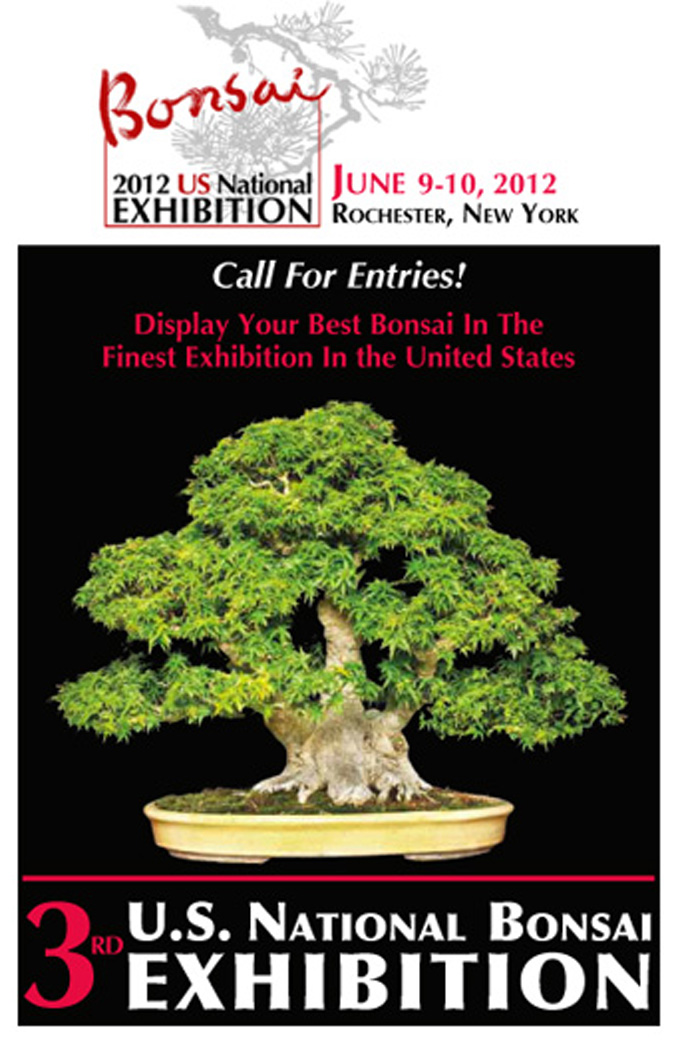

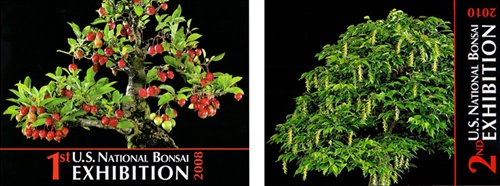 2008 & 2010 Exhibition Albums at deep discounts
2008 & 2010 Exhibition Albums at deep discounts
Source: Bonsai Bark Read more!
Have you thought about entering your bonsai in next year‘s US National Bonsai Exhibition? Why not? Not only will it focus your mind on your bonsai, but you’ll no doubt learn something in the process. Not to mention that, if your tree is accepted, it will show up in the 2012 Exhibition Album. And then, there’s always the chance you could win something.
You can contact Bill Valavanis for details: WNV@internationalbonsai.com
Even you if don’t enter, this is a good time to start planning your visit.


 2008 & 2010 Exhibition Albums at deep discounts
2008 & 2010 Exhibition Albums at deep discountsSource: Bonsai Bark Read more!
Tuesday, October 25, 2011
Bonsai tree: Sequoia deadwood
Source: Bonsai Tonight
Sequoia deadwood
Deadwood, beyond fire scars, is not a major characteristic of mature sequoia. It is, however, a major characteristic of their environs as dead trees take a very long time to decompose. The beautiful and sinuous grain of the deadwood offers suggestions for our own deadwood carving. Nature, it seems, always gets it right.
Toppled tree at Grant Grove with hollowed out center – it’s big enough to walk through
Side view, same tree
Nebari from underneath
Wavy wood grain
Rootbase of Auto Log – a toppled tree on which cars used to park
More Auto Log
The other prevalent deadwood in the Park results from fire damage, of which, there is plenty to be found.
Smoldering landscape
The apex of Dead Giant
The trail at Redwood Grove leads through the hollow trunk of this tree
Looking down the barrel of a gigantic fallen sequoia
All of these sites are easily accessible by car and by foot – see National Park Service map of the area for details.
Read more!
Monday, October 24, 2011
Bonsai tree: Weekly Wire #4
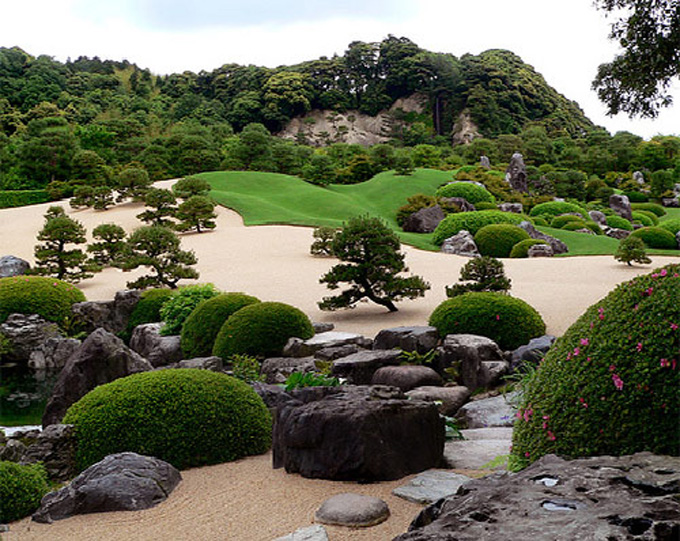 The Adachi Museum Garden is featured the Japan Journey’s Gardens of Japan tour next month (Nov 11-22). Though I’ve never been to the Adachi gardens, judging from the photos, I just might agree with those who say it’s among the world’s most glorious gardens; Japanese or otherwise.
The Adachi Museum Garden is featured the Japan Journey’s Gardens of Japan tour next month (Nov 11-22). Though I’ve never been to the Adachi gardens, judging from the photos, I just might agree with those who say it’s among the world’s most glorious gardens; Japanese or otherwise.Bonsai clubs. Looking for a Bonsai Club near you? Here’s the ABS Bonsai Club Directory.
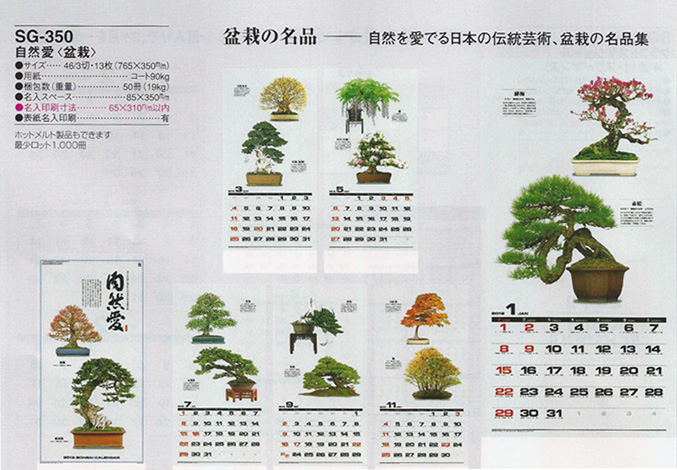 Calendars. Our 2012 Bonsai calendars are coming soon. Stay posted.
Calendars. Our 2012 Bonsai calendars are coming soon. Stay posted.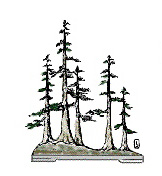
The Mid-Atlantic 2012 Spring Festival is scheduled for April 20-22. This excellent show has long been a premier East Coast bonsai event.
Our Bonsai from Scratch Contest. We’ve received all the final submissions and the judges have been notified. Next, comes the judging (it will be blind – they’ll receive no names with the photos), and finally the posting of the results. Please be patient. All this will take time (my best guess is at least a month to get everything sorted out).
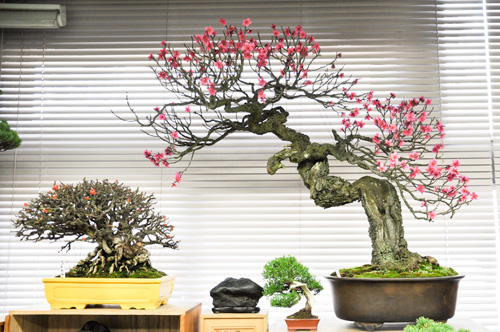 The Green Club. If you’re ever in Japan, you don’t want to miss the world’s most famous bonsai market. A while back we featured a post on Japan’s Green Club. Now, Bonsai Tonight is offering you the opportunity to dig deeper into this wonderful world of magnificent and often astoundingly pricey bonsai for sale.
The Green Club. If you’re ever in Japan, you don’t want to miss the world’s most famous bonsai market. A while back we featured a post on Japan’s Green Club. Now, Bonsai Tonight is offering you the opportunity to dig deeper into this wonderful world of magnificent and often astoundingly pricey bonsai for sale.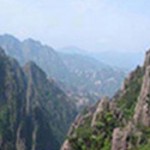
China tour. I think there is still space available for Dan Robinson’s Elandan China tour (April 2012).
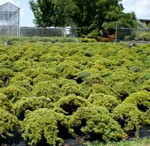
Plant City Bonsai is offering Advanced Classes with Warren Hill Oct 29th & 30th.
 The National Bonsai & Penjing Collection of Australia. I’ve seen Bottlebrush used as street trees in San Francisco, but I don’t think I’ve ever seen an impressive Bottlebrush bonsai (I have seen overpriced little commercial Bottlebrush online). Until now that is. This one is part of the National Bonsai & Penjing Collection of Australia in Canberra. The artist is Derek Oakley.
The National Bonsai & Penjing Collection of Australia. I’ve seen Bottlebrush used as street trees in San Francisco, but I don’t think I’ve ever seen an impressive Bottlebrush bonsai (I have seen overpriced little commercial Bottlebrush online). Until now that is. This one is part of the National Bonsai & Penjing Collection of Australia in Canberra. The artist is Derek Oakley. Mountain lake from the Minnesota Bonsai Society’s Newsletter. They are offering a tool maintenance class, Nov 15.
Mountain lake from the Minnesota Bonsai Society’s Newsletter. They are offering a tool maintenance class, Nov 15.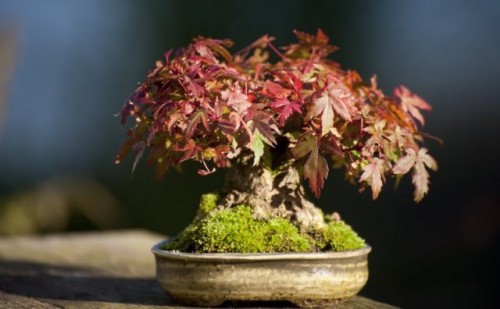 More fall color. The other day we featured a fall color gallery (Blazing Bonsai). Continuing in that vibrant vein, here’s one we missed. It’s a Japanese maple from Morten Albek’s Shohin blog. Morten is the author of Majesty in Miniature: Shohin Bonsai.
More fall color. The other day we featured a fall color gallery (Blazing Bonsai). Continuing in that vibrant vein, here’s one we missed. It’s a Japanese maple from Morten Albek’s Shohin blog. Morten is the author of Majesty in Miniature: Shohin Bonsai.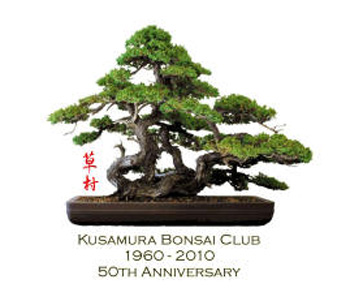 The Kusamura Bonsai Club (Palo Alto, California) is offering a potting party Nov 13th. Their annual bonsai show is scheduled for April 21-22 2012.
The Kusamura Bonsai Club (Palo Alto, California) is offering a potting party Nov 13th. Their annual bonsai show is scheduled for April 21-22 2012.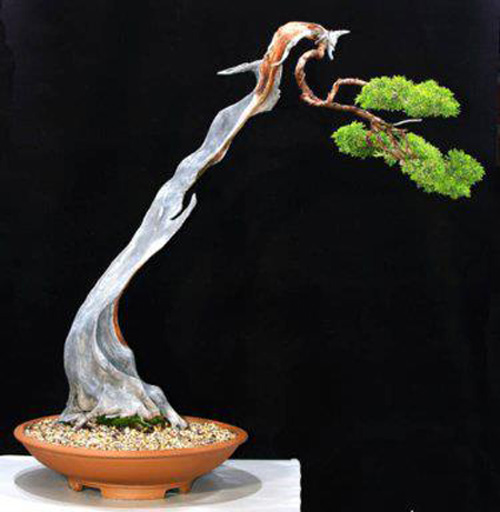 This strange and wild bunjin finishes with an unconventional (and a little unsettling) pincer-like flourish at the top. It popped up on facebook; which brings up the facebook dilemma.
This strange and wild bunjin finishes with an unconventional (and a little unsettling) pincer-like flourish at the top. It popped up on facebook; which brings up the facebook dilemma. The facebook dilemma
Bonsai photos abound on facebook and I suppose this is a good thing. The problem is, often the trees are unattributed, or even falsely attributed. I know this doesn’t matter to many people, but if you’re interested in what a tree is and who styled it, you’re often left in the dark. This is the case with the strange, but kind of compelling tree above. I’d be interested to see Robert Steven do a critique on this one.
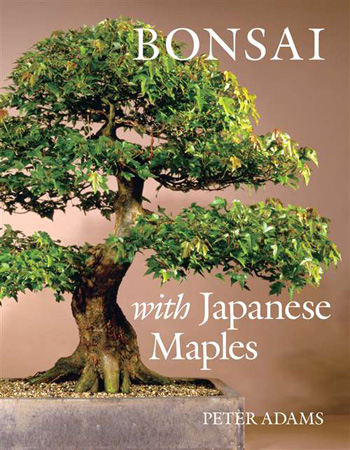 Bonsai with Japanese Maples. Paul Stokes has some book reviews on his web magazine, of Bonsai. Here’s one on Bonsai with Japanese Maples (available at Stone Lantern) you might find helpful, especially if you are growing or thinking or growing any of these superb trees (BTW: interestingly, the tree on the cover is a Trident maple, not a Japanese maple).
Bonsai with Japanese Maples. Paul Stokes has some book reviews on his web magazine, of Bonsai. Here’s one on Bonsai with Japanese Maples (available at Stone Lantern) you might find helpful, especially if you are growing or thinking or growing any of these superb trees (BTW: interestingly, the tree on the cover is a Trident maple, not a Japanese maple).Source: Bonsai Bark Read more!
Subscribe to:
Comments (Atom)
